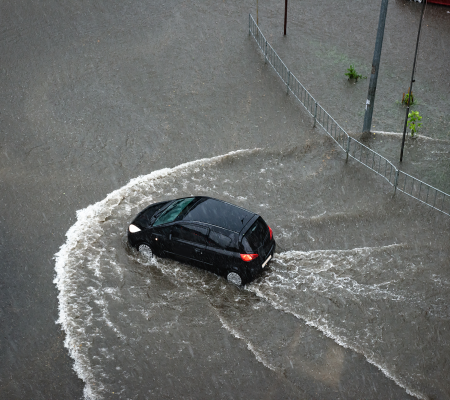Climate change brings with it extreme weather events, which are increasingly frequent occurrences. Warming the Earth’s atmosphere and oceans leads to changes in precipitation patterns, increasing the risk of flooding in many countries.
Slovenia is a small country located in Central Europe. Its topography is diverse and includes both the Alps and the Adriatic Sea. It has a diverse climate, which can contribute to variations in the amount of precipitation in different regions of the country. Slovenia has faced several major floods caused by extraordinary rainfall in the past, but they have never happened that floods occurred at the same time in almost two-thirds of the country, as they happened between 4 and 8 August 2023.
From August 3 to 6, Slovenia was hit by a rainy period accompanied by thunderstorms, heavy downpours, and showers. Unfortunately, no one expected such a scale of flooding The The civil defense system was on alert due to the incoming warnings. Otherwise, the consequences of these floods would have been even greater.
According to the Slovenian Environmental Agency report, from August 4 to 8, high water levels were exceeded at 122 water measuring stations on 74 rivers. In addition to the river floods,, there was also an overflow of the sea on the Slovenian coast. Catastrophic floods take away lives, houses, lands, and roads, and the consequences are felt almost 6 months after them, and unfortunately, they will be felt for a long time.
The Government of the Republic of Slovenia estimated that the total damage related to the population, the economy, and the environment caused by these floods is about 9.9 billion euros. The floods damaged an area of about 17,203 square kilometres, which includes the territory of 183 municipalities. There are still no official results of damage assessments, but there are certainly preliminary ones.
Unfortunately, three lives were lost in the August floods. The flooding affected a substantial number of households, with 10,000 to 15,000 experiencing some level of impact. The destruction of 34 houses and rendering 484 residential buildings uninhabitable underscores the significant damage to the housing infrastructure.
As a result of the devastating floods, more than 30 km of roads were destroyed, and in some places, the infrastructure that was restored shortly before the floods was destroyed.
Mitigating the impact of floods associated with climate change involves a combination of adaptation and mitigation strategies, including improved infrastructure, sustainable land use planning, and global efforts to reduce greenhouse gas emissions. Addressing climate change on a global scale is crucial to minimizing the risks and damages associated with flooding and other climate-related impacts.
We consider and believe that new ways of education, as well as spreading awareness, are the main weapons in saving our planet and will be proposed in the form of a board game, community mapping, and a communication app. Our project contributes in many ways, for example, through a hands-on manual to teach how to make maps and infographics in the context of flood assessment, prevention, and response.
Our Community Mapping will provide a platform for diverse voices and experiences to be represented on the map. It ensures that marginalised groups, including vulnerable populations at higher risk of flooding, have a say in identifying and addressing their needs and concerns.
Our goal is to create local and online accessible maps together with students, and we believe it will be a valuable tool for promoting the democratization of local knowledge and providing useful information to citizens, including an analysis of the perception of flooding risks in the local communities.
The next meeting of partners will be held on March 21 in Slovenia, in sunny Portorož, on the coast of the Adriatic Sea. The meeting will be held as part of the 43rd International Scientific Conference on the Development of Organizational Sciences, organised by the Faculty of Organizational Sciences, University of Maribor. The name of this year’s conference is “Green and Digital Transition – Challenge or Opportunity” and it will be a great place to exchange good ideas, towards a better and greener future.
We can only succeed if we perform together. Keep following us on this journey!





